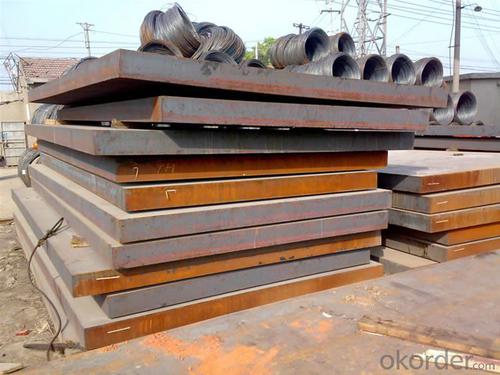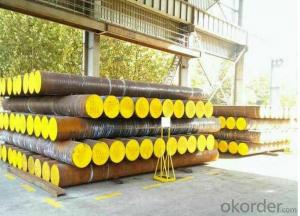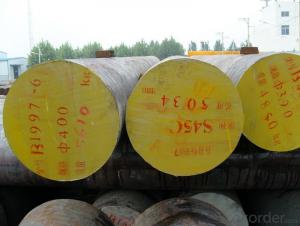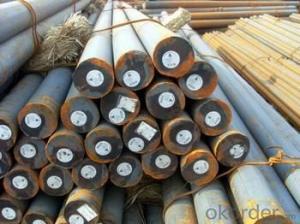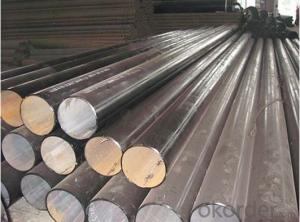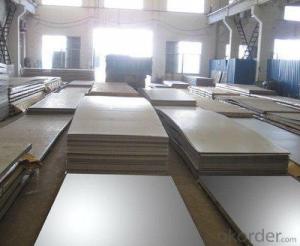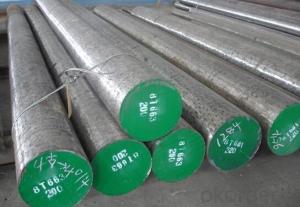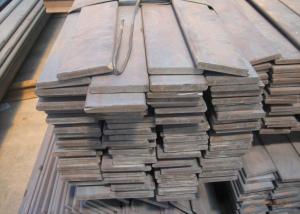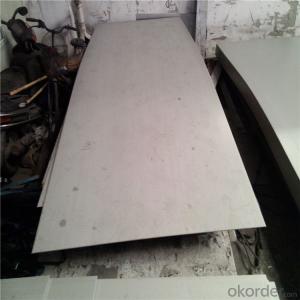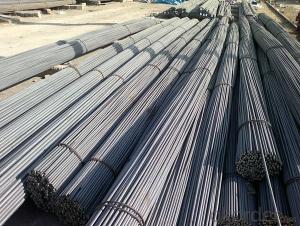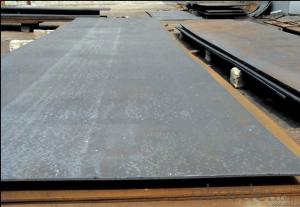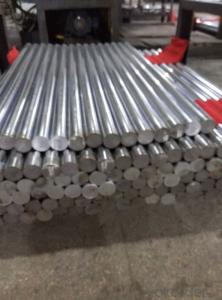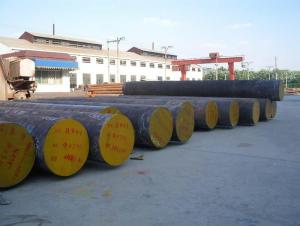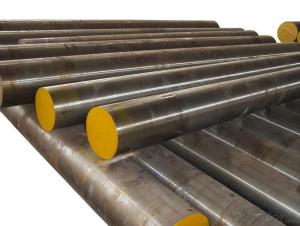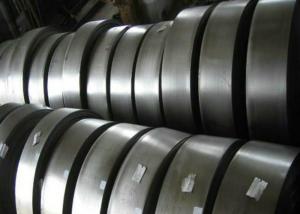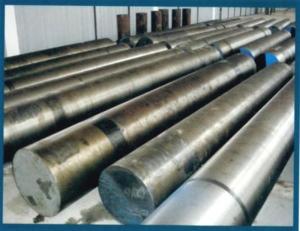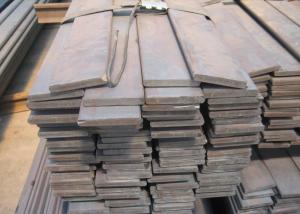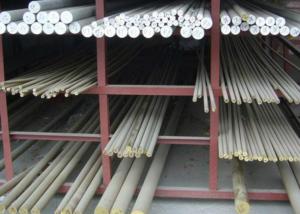Hot Rolled 5140 Steel, 5140 Steel Structure, 5140 Steel Plate
- Loading Port:
- China main port
- Payment Terms:
- TT OR LC
- Min Order Qty:
- 25 m.t.
- Supply Capability:
- 10000 m.t./month
OKorder Service Pledge
OKorder Financial Service
You Might Also Like
Specification
Hot Rolled 5140 Steel, 5140 Steel Structure, 5140 Steel Plate
Equivalent grades
| GB | DIN | AISI | JIS |
| 42CrMo | 1.7225 | 4140 | SCM440 |
Chemical Composition
| C | Si | Mn | Cr | Mo | P | S |
| 0.38-0.43 | 0.40max | 0.60-0.90 | 0.90-1.20 | 0.15-0.30 | ≤0.035 | ≤0.035 |
Available size
| Round steel bar 60-800mm | |||||||||
| Flat steel bar 25-400mm*200-800mm |
Surface condition
| Black surface/ Grinded/ Machined |
Hardness
| Annealed HBS 217 max |
Characteristics
| 4140 Alloy Steel/SAE 4140 Steel Price is engineering steel supplied in quenched and tempered conditions. Very good machinability. High toughness. High creep strength. Repeated impact resistant capability. |
Applications
| 4140 Alloy Steel/SAE 4140 Steel Price is use to producecomponents with high requirements on toughness, e.g. gear wheels, pinions, connecting rods, parts for mechanical engineering . |
Heat treatment
| Forging | Heat to 1150°C. Hold until uniform. Minimum forging temperature 850°C.Cool slowly in ashes or sand etc. | ||||||||
| Annealing | Heat to 830°C-850°C.Cool in furnace. | ||||||||
| Normalising | Heat to 870°C-900°C.Cool in still air. | ||||||||
| Stress Relieving | Annealed: Heat to 600°C-650°C.Hardened: Heat to 500°C-550°C.Cool in still air. | ||||||||
| Hardening | Heat to 830°C-880°C. Quench in oil or polymer. | ||||||||
| Tempering | Heat to 450°C-700°C cool in still air. NB. Tempering within the range 200°C-420°C will result in temper brittleness and should be avoided. | ||||||||
Product Show:
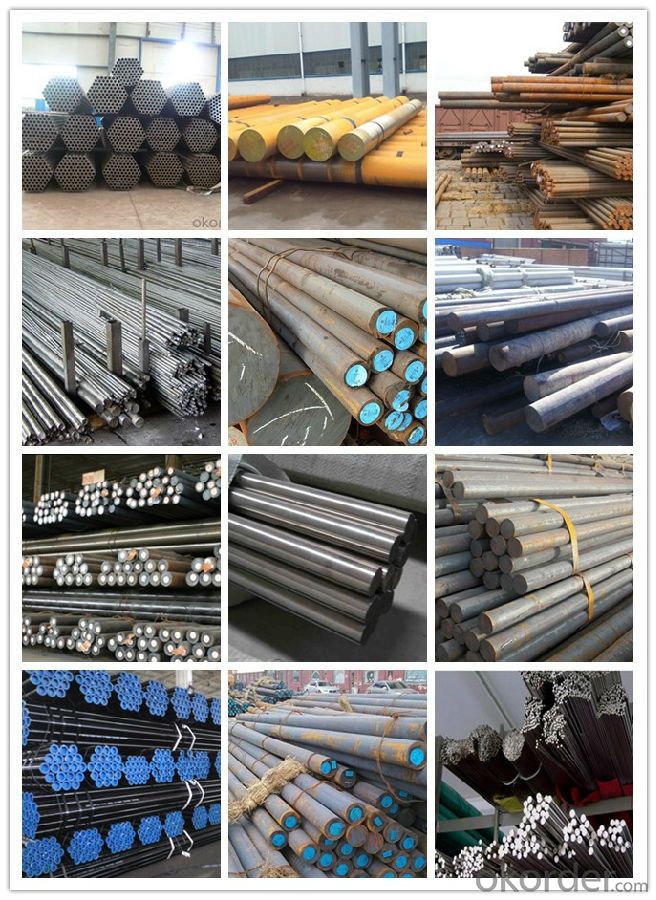
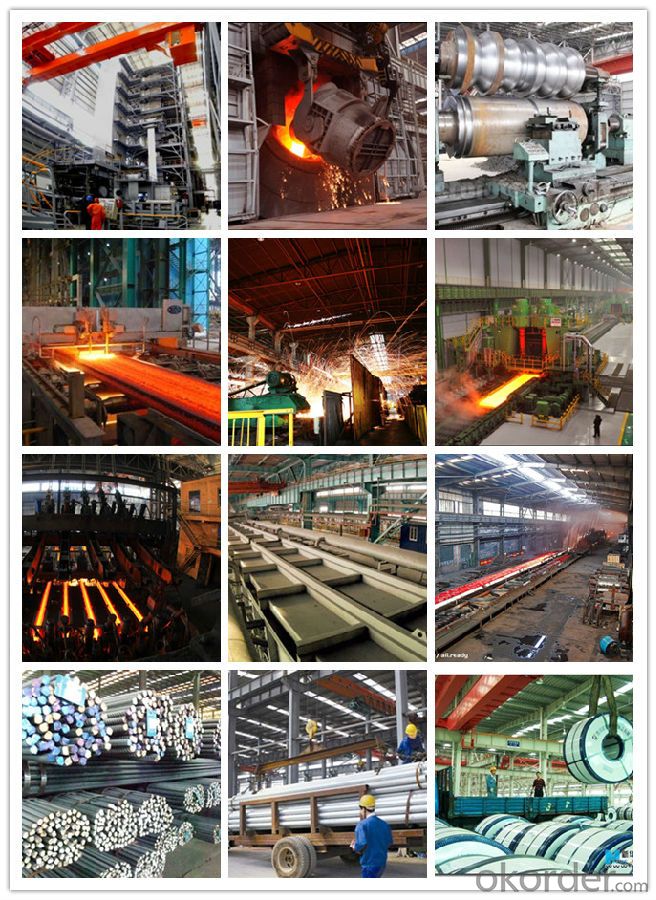
1, Your advantages?
professional products inquiry, products knowledge train (for agents), smooth goods delivery, excellent customer solution proposale
2, Test & Certificate?
SGS test is available, customer inspection before shipping is welcome, third party inspection is no problem
3, Payment Terms?
30% TT as deposit and 70% before delivery.
Irrevocable L/C at sight.
4, Trading Terms?
EXW, FOB, CIF, FFR, CNF
6, After-sale Service?
WE provides the services and support you need for every step of our cooperation. We're the business partner you can trust.
For any problem, please kindly contact us at any your convenient time.
We'll reply you in our first priority within 24 hours.
- Q: Can special steel be used in the manufacturing of household appliances?
- Yes, special steel can be used in the manufacturing of household appliances. Special steel, also known as alloy steel, offers a range of desirable properties such as high strength, durability, and resistance to corrosion and wear. These characteristics make it suitable for various applications, including the production of household appliances. Household appliances such as refrigerators, ovens, dishwashers, and washing machines require materials that can withstand constant use, high temperatures, and exposure to water and chemicals. Special steel fulfills these requirements and provides a reliable and long-lasting solution. For example, stainless steel is a type of special steel commonly used in household appliances due to its corrosion resistance and hygienic properties. It is used in appliance components such as refrigerator doors, oven interiors, and dishwasher interiors. Stainless steel is easy to clean, maintains its appearance over time, and does not react with food or other substances, making it an ideal choice for household appliances. Additionally, special steel alloys can be used to enhance specific properties needed in different appliances. For instance, heat-resistant alloys can be utilized in ovens or stovetops, while high-strength steel alloys can be employed in appliances that require structural integrity, like washing machines or dryers. In summary, special steel can definitely be used in the manufacturing of household appliances. Its various properties, including strength, durability, resistance to corrosion, and versatility, make it an excellent material choice for ensuring the performance, longevity, and safety of household appliances.
- Q: How does special steel contribute to the marine machinery industry?
- Special steel contributes to the marine machinery industry by offering high strength, corrosion resistance, and excellent mechanical properties. This enables the construction of durable and reliable components such as propeller shafts, rudder stocks, and engine parts that can withstand harsh marine environments. The use of special steel enhances the performance and longevity of marine machinery, ensuring efficient and safe operations at sea.
- Q: How does special steel contribute to reducing product downtime?
- Special steel contributes to reducing product downtime by offering superior strength, durability, and corrosion resistance compared to regular steel. This allows for the manufacturing of high-performance components that can withstand harsh operating conditions, reducing the likelihood of breakdowns or failures. Additionally, special steel's enhanced wear resistance prolongs the lifespan of products, minimizing the need for frequent replacements or repairs. Overall, the use of special steel in various industries helps to ensure reliable and uninterrupted operation, leading to reduced downtime and increased productivity.
- Q: What are the common challenges in heat treating titanium alloys?
- Heat treating titanium alloys can present several common challenges. One of the main challenges is the high reactivity of titanium with oxygen, nitrogen, and hydrogen at elevated temperatures. This reactivity can lead to surface contamination and the formation of undesirable oxides, nitrides, or hydrides, which can affect the mechanical properties of the alloy. Another challenge is the formation of alpha-case, a thick layer of alpha-phase titanium on the surface of the alloy during heat treatment. Alpha-case is brittle and can significantly reduce the fatigue strength and ductility of the material. Therefore, minimizing or eliminating the formation of alpha-case is crucial in heat treating titanium alloys. Furthermore, titanium alloys have a narrow temperature range for effective heat treatment. If the temperature is too low, it may not achieve the desired microstructure and mechanical properties. On the other hand, if the temperature is too high, it can lead to grain growth, which can reduce the strength and toughness of the alloy. Additionally, the heat treatment of titanium alloys often requires precise control of the heating and cooling rates to achieve the desired microstructure and properties. Rapid or uneven cooling can result in non-uniform microstructures, residual stresses, or distortion of the part. Finally, the cost of heat treating titanium alloys can be a challenge. Titanium alloys have a high affinity for oxygen, which necessitates the use of specialized equipment, such as vacuum furnaces or controlled atmosphere furnaces, to maintain a low oxygen environment. These specialized heat treatment processes can be expensive and require careful handling and maintenance to ensure the desired results. In conclusion, the common challenges in heat treating titanium alloys include managing reactivity with oxygen, nitrogen, and hydrogen, minimizing alpha-case formation, achieving the correct temperature range, controlling heating and cooling rates, and dealing with the cost of specialized equipment and processes. Overcoming these challenges is essential to obtain high-quality titanium alloy components with desired properties.
- Q: What are the different grades of special steel?
- There are several grades of special steel, including stainless steel grades such as 304, 316, and 430; tool steel grades like D2, O1, and A2; and high-speed steel grades such as M2 and M42. Each grade has unique properties and applications, making them suitable for various industries and specific purposes.
- Q: What are the different surface treatment methods used for special steel?
- There are several different surface treatment methods used for special steel, including but not limited to electroplating, galvanizing, powder coating, and heat treatment. These methods help to enhance the corrosion resistance, improve the appearance, and increase the durability of special steel products.
- Q: What are the challenges in heat treatment of special steel alloys?
- The heat treatment of special steel alloys presents various difficulties due to their unique composition and properties. One of the primary obstacles is attaining the desired microstructure and mechanical properties while maintaining dimensional stability. Special steel alloys often contain intricate alloying elements and necessitate specific heat treatment processes to achieve the desired properties. Another hurdle involves controlling the rates of heating and cooling throughout the heat treatment procedure. Special steel alloys are often sensitive to rapid or uneven temperature changes, which can lead to distortion, cracking, or the formation of undesirable phases. Hence, ensuring precise control of the heating and cooling rates is crucial to avoid these issues and ensure uniformity in the final product. Furthermore, the presence of alloying elements in special steel alloys can increase their hardenability, making it challenging to achieve the desired hardness consistently across the entire component. Adequate attention must be given to selecting appropriate heat treatment parameters, including temperatures, soaking times, and quenching media, in order to achieve the desired hardness and prevent excessive hardness gradients. Additionally, special steel alloys are prone to oxidation and decarburization during heat treatment due to their high alloy content and exposure to elevated temperatures. These reactions can result in surface defects and a decrease in carbon content, thereby impacting the final properties of the alloy. Consequently, careful control of protective atmospheres or heat treatment environments is necessary to prevent such issues. Moreover, the size and shape of components made from special steel alloys can pose challenges during heat treatment. Large or intricately shaped components require careful consideration of heating and cooling methods to ensure uniformity in microstructure and properties throughout the entire component. This may involve the use of specialized furnaces, fixtures, or heat treatment cycles to overcome these challenges. In conclusion, the challenges involved in heat treating special steel alloys encompass achieving the desired microstructure and mechanical properties, controlling heating and cooling rates, managing hardenability, preventing oxidation and decarburization, and addressing the size and shape of components. Overcoming these challenges demands a comprehensive understanding of the alloy's composition, properties, and the application of appropriate heat treatment techniques.
- Q: How does special steel contribute to the aerospace racing industry?
- Special steel plays a crucial role in the aerospace racing industry by offering superior strength, durability, and performance characteristics that are essential for the demanding conditions and requirements of high-speed racing. One of the primary contributions of special steel to the aerospace racing industry is its ability to withstand extreme temperatures and pressures. Special steel alloys, such as nickel-based superalloys, are specifically designed to maintain their mechanical properties under high temperatures, making them ideal for the intense heat generated during racing. These alloys exhibit excellent creep resistance, allowing the components to withstand prolonged exposure to elevated temperatures without deformation or failure. Moreover, special steel alloys possess exceptional strength-to-weight ratios, providing a competitive advantage in the aerospace racing industry. The high strength of these alloys allows for the design and construction of lighter and more efficient racing components, such as engine parts, landing gears, and structural elements. This reduces the overall weight of the aircraft, enhancing its performance and speed while maintaining structural integrity and safety. Additionally, special steel offers excellent corrosion resistance, which is vital in the aerospace racing industry. The harsh conditions experienced during racing, including exposure to moisture, chemicals, and atmospheric elements, can lead to corrosion and deterioration of critical components. Special steel alloys, such as stainless steel, are highly resistant to corrosion, ensuring the longevity and reliability of the racing aircraft. Furthermore, special steel's unique metallurgical properties, such as high fatigue and fracture resistance, contribute to the safety and reliability of the aerospace racing industry. The high fatigue strength of these alloys allows them to withstand repeated loading and unloading cycles without developing cracks or failures. This is crucial in high-speed racing, where components are subjected to significant stress and strain. Special steel's exceptional fracture toughness also ensures that any potential cracks or flaws do not propagate catastrophically, minimizing the risk of catastrophic failures during racing. In conclusion, special steel plays a pivotal role in the aerospace racing industry by offering superior strength, durability, and performance characteristics. Its ability to withstand extreme temperatures, provide excellent strength-to-weight ratios, resist corrosion, and exhibit high fatigue and fracture resistance makes it an indispensable material for the construction of racing aircraft components. The use of special steel in the aerospace racing industry ultimately enhances the performance, speed, safety, and reliability of racing aircraft, pushing the boundaries of aerospace technology and propelling the industry forward.
- Q: How is free-cutting steel used in the production of precision components?
- Free-cutting steel is used in the production of precision components due to its excellent machinability properties. Its composition includes added elements such as sulfur, lead, or bismuth, which aid in chip breaking and reducing tool wear during machining processes. This steel variant allows for high-speed machining operations, resulting in improved productivity and accuracy when manufacturing precision components.
- Q: What are the requirements for special steel used in metalworking tools?
- To ensure the effectiveness and durability of metalworking tools, specific characteristics and qualities are necessary for the special steels used in their production. Key requirements for these steels include: 1. High hardness: The special steels must possess a high level of hardness to resist wear and deformation, enabling the tools to maintain their sharpness and cutting edge for extended periods. This results in efficient and precise machining operations. 2. Excellent toughness: Given the high impact and stress loads experienced by metalworking tools, they must have excellent toughness to withstand the forces encountered during cutting, drilling, or shaping operations. This toughness prevents the tools from fracturing or chipping, ensuring a longer tool life. 3. Good heat resistance: The performance of metalworking tools can be compromised by the significant heat generated during the machining process. Therefore, the special steels used in these tools should exhibit good heat resistance to minimize the risk of thermal damage, even at elevated temperatures. 4. Wear resistance: Metalworking tools are constantly in contact with the workpiece, making the ability to resist wear crucial. Special steels used in these tools should have high wear resistance to maintain their cutting performance and dimensional accuracy over time. 5. Corrosion resistance: Metalworking tools often encounter harsh environments with coolants, lubricants, and corrosive elements. To prevent rusting and degradation, the special steels used in these tools should possess good corrosion resistance, ensuring the longevity and reliability of the tools. 6. High dimensional stability: Special steels used in metalworking tools must exhibit high dimensional stability to guarantee consistent performance. This stability allows the tools to maintain their shape and size under varying operating conditions, resulting in accurate and repeatable machining processes. 7. Machinability: The special steels used in metalworking tools should be easily processed and shaped into the desired tool design. This characteristic enables cost-effective manufacturing, reducing production time and expenses. By meeting these requirements, the special steels used in metalworking tools can withstand the demanding conditions encountered in various metal fabrication and machining operations. They provide efficient cutting, shaping, and drilling capabilities while maintaining longevity and performance.
Send your message to us
Hot Rolled 5140 Steel, 5140 Steel Structure, 5140 Steel Plate
- Loading Port:
- China main port
- Payment Terms:
- TT OR LC
- Min Order Qty:
- 25 m.t.
- Supply Capability:
- 10000 m.t./month
OKorder Service Pledge
OKorder Financial Service
Similar products
Hot products
Hot Searches
Related keywords



